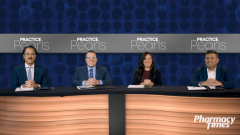
Emicizumab Adherence in Hemophilia A: Real-World Insights
Experts discuss adherence to emicizumab in real-world settings, comparing it to factor products and highlighting the convenience and ease of administration associated with emicizumab.
Episodes in this series

Jonathan Ogurchak, PharmD, CSP: Emicizumab. We’ve been talking a lot about that. It was approved back in 2018 to prevent or reduce the frequency of bleeding in episodes with adults and [pediatric patients] with hemophilia A with or without factor A. In clinical trials, you see one thing. But in the real world, it’s a totally different story. Dr Chowdhry, what have you seen in the real world setting as far as adherence to emissive med?
Atta Chowdhry, RPh: In my practice, I’ve seen it like the adherence is pretty good among, I think, all the patients. I have one kid who had to get back on it because that was skipping. And [there were] a bunch of other reasons involved. But the study I looked at…was a retrospective study done through the peer data of how often the emicizumab was ordered as compared to factor [products]. And they find the emicizumab better adherence rate as compared to the factor products. Once you pass that first 4 weeks of burning sensation apart with the emissive map, I think then after that is a lot of smooth sailing for folks. They try to stick with the product because even though if you look at it subcutaneous versus intravenous [IV], I think [IV] access is a little bit harder to do, so I think maybe it had to do with that, maybe not. But in general, all in all I’ve seen better adherence with the emicizumab as compared to the factor product.
Jonathan Ogurchak, PharmD, CSP: We’ve also seen adherence after switching. We talked a little bit about that earlier, Dr Schrade. Is there any real-world evidence as it relates to success or lack thereof in switching from factor to emicizumab?
Lisa Schrade, PharmD: Definitely. In the study those concluded the difference between emicizumab and prophylaxis therapy on factor VIII product. They’ve shown greater adherence to their therapy. Again, just like Dr Chowdhry had talked about, just like I have talked about, it’s all about the burden of administration. You’re going to find that’s a lot easier for patients, families, mothers that have multiple children in the household to try to administer a subcutaneous injection. What’s nice about emicizumab that it’s already in its usable form. All you have to do is draw it up from the vial. There’s no mixing involved. The injection volume is quite small so the subcutaneous injection can be administered quickly. There’s no trying to locate a vein like you have to for IV so if you have a patient who is on multiple IV infusions for factor therapy, trying to find a vein sometimes can be problematic if they’re dehydrated. Lots of factors come into play with that. Whereas with emicizumab, because it is subcutaneous, my general rule of thumb is “If there’s skin stick it in.” We go for the general injection sites, the abdominal area, arms, legs, just whatever’s easiest for patients. There are multiple avenues of injection, again, because it’s so easy to prepare it. Most patients and families enjoy that luxury of freedom too when they’re traveling because of the therapy being administered anywhere between [every] week to every 28 days. There’s that freedom of dosing. If they want to travel, they don’t have to take boxes of factor and refrigerated products and try to explain to TSA [Transportation Security Administration] why they have a huge cooler full of vials of liquid stuff. That’s what helps with that adherence.
Robert Sidonio Jr, MD, MSc: Families would tell us this, about [how] they would travel and they’d have a whole suitcase. It’s just factor products. And, of course, they have to explain this. We’d have to have to write a letter explaining to TSA what this is because it’s a little strange for them to see this. So they definitely could pack lighter and [have] a little bit more freedom, of course.
Atta Chowdhry, RPh: Then, the emicizumab, if you are going on a vacation, with consultation with the treatment center, you can have a double dose. If your physician, the hematologist, allows you to before you go in because of the half-life of the product that it stays in your system that long that you’d be just fine doing that for that time being.
Transcript is AI generated and reviewed by a Pharmacy Times editor.
Newsletter
Stay informed on drug updates, treatment guidelines, and pharmacy practice trends—subscribe to Pharmacy Times for weekly clinical insights.










































































































































































































